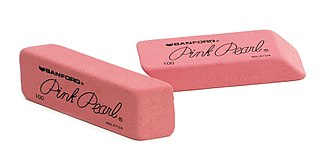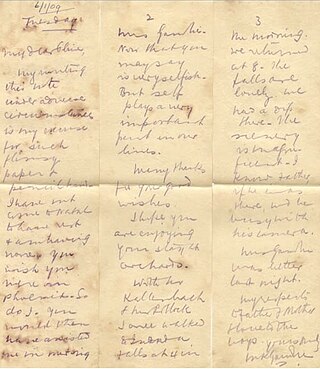
A ballpoint pen, also known as a biro, ball pen, or dot pen, is a pen that dispenses ink over a metal ball at its point, i.e., over a "ball point". The metals commonly used are steel, brass, or tungsten carbide. The design was conceived and developed as a cleaner and more reliable alternative to dip pens and fountain pens, and it is now the world's most-used writing instrument; millions are manufactured and sold daily. It has influenced art and graphic design and spawned an artwork genre.

Drawing is a visual art that uses an instrument to mark paper or another two-dimensional surface. The instrument might be pencils, crayons, pens with inks, brushes with paints, or combinations of these, and in more modern times, computer styluses with graphics tablets.

Ink is a gel, sol, or solution that contains at least one colorant, such as a dye or pigment, and is used to color a surface to produce an image, text, or design. Ink is used for drawing or writing with a pen, brush, reed pen, or quill. Thicker inks, in paste form, are used extensively in letterpress and lithographic printing.

A pencil is a writing or drawing implement with a solid pigment core in a protective casing that reduces the risk of core breakage, and keeps it from marking the user's hand.

A whiteboard is a glossy, usually white surface for making non-permanent markings. Whiteboards are analogous to blackboards, but with a smoother surface allowing for rapid marking and erasing of markings on their surface. The popularity of whiteboards increased rapidly in the mid-1990s and they have become a fixture in many offices, meeting rooms, school classrooms, public events and other work environments.

A marker pen, fine liner, marking pen, felt-tip pen, felt pen, flowmarker, sign pen, vivid, flomaster, texta, sketch pen, koki or simply marker is a pen which has its own ink source and a tip made of porous, pressed fibers such as felt. A marker pen consists of a container and a core of an absorbent material that holds the ink. The upper part of the marker contains the nib that was made in earlier times of a hard felt material, and a cap to prevent the marker from drying out.

An eraser is an article of stationery that is used for removing marks from paper or skin. Erasers have a rubbery consistency and come in a variety of shapes, sizes, and colors. Some pencils have an eraser on one end. Erasers come in all kinds of shapes and colors. Less expensive erasers are made from synthetic rubber and synthetic soy-based gum, but more expensive or specialized erasers are made from vinyl, plastic, or gum-like materials.

The hectograph, gelatin duplicator or jellygraph is a printing process that involves transfer of an original, prepared with special inks, to a pan of gelatin or a gelatin pad pulled tight on a metal frame.
A penciller is an artist who works on the creation of comic books, graphic novels, and similar visual art forms, with a focus on the initial pencil illustrations, usually in collaboration with other artists, who provide inks, colors and lettering in the book, under the supervision of an editor.

Iron gall ink is a purple-black or brown-black ink made from iron salts and tannic acids from vegetable sources. It was the standard ink formulation used in Europe for the 1400-year period between the 5th and 19th centuries, remained in widespread use well into the 20th century, and is still sold today.

A tortillon is a cylindrical drawing tool, tapered at the end and usually made of rolled paper, used by artists to smudge or blend marks made with charcoal, Conté crayon, pencil or other drawing utensils.
Paper Mate is a division of Sanford L.P., a Newell Brands company that produces writing instruments. Paper Mate's offices are located in Oak Brook, Illinois, along with those of Newell Rubbermaid's other office products divisions.
A writing implement or writing instrument is an object used to produce writing. Writing consists of different figures, lines, and or forms. Most of these items can be also used for other functions such as painting, drawing and technical drawing, but writing instruments generally have the ordinary requirement to create a smooth, controllable line.
Lamy is a German pen manufacturing company founded in 1930 by Josef Lamy, a former sales representative for Parker Pen. The company acquired the Orthos pen manufacturer to begin production. Lamy is known for its innovative use of materials, particularly molded synthetic plastics in their pen designs.

A kneaded eraser, also commonly known as a putty rubber, is a pliable erasing tool used by artists. It is usually made of a grey or white unvulcanized rubber resembling putty or chewing gum. It functions by absorbing and "picking up" graphite and charcoal particles, in addition to carbon, colored pencil, or pastel marks. It neither wears nor leaves residue, thereby lasting much longer than other erasers.

Erasermate is an erasable pen introduced by the Paper Mate division of the Gillette Company in 1979.

Artists' charcoal is charcoal used as a dry art medium. Both compressed charcoal and charcoal sticks are used. The marks it leaves behind on paper are much less permanent that with other media such as graphite, and so lines can easily be erased and blended. Charcoal can produce lines that are very light or intensely black. The dry medium can be applied to almost any surface from smooth to very coarse. Fixatives are used with charcoal drawings to solidify the position to prevent erasing or rubbing off of charcoal dusts.

A copying pencil, also an indelible pencil or chemical pencil, is a pencil whose lead contains a dye. The lead is fabricated by adding a dry water-soluble permanent dye to powdered graphite—used in standard graphite pencils—before binding the mixture with clay.
















